

Four-strand DNA structure found in cells. Jean-Paul Rodriguez Four DNA strands come together in this model, built using data from x-ray crystallography.
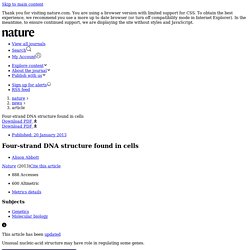
Directed Evolution Teaches an Old Enzyme New Tricks. Cyclopropanation is a new app for an old enzyme.

(Image Credit: Pedro Coehlo) Over the last few billion years, chemical reactions have run rampant on planet Earth, combining atoms and molecules in new and increasingly complex ways, testing the limits of universal physical laws. Through the evolutionary force of natural selection, these reactions created self-replicating nucleic acids, microbial cells, wooly mammoths, and, perhaps the pinnacle of evolution, Duck Dynasty. FGF-2 regulation of neurogenesis in adult hippocampus after brain injury. Author Affiliations Edited by Bruce S.
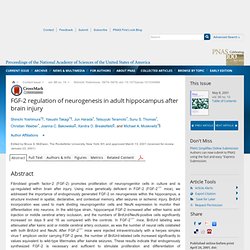
McEwen, The Rockefeller University, New York, NY, and approved March 13, 2001 (received for review January 22, 2001) Abstract. Interferon-Induced SCYL2 Limits Release of HIV-1 by Triggering PP2A-Mediated Dephosphorylation of the Viral Protein Vpu. Move over DNA: Six new molecules can carry genes - life - 19 April 2012. By Michael Marshall All of a sudden, DNA has no reason to feel special.
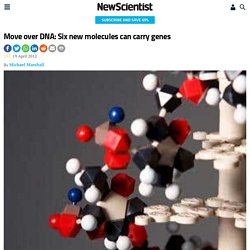
For decades it seemed that only a handful of molecules could store genetic information and pass it on. But now synthetic biologists have discovered that six others can pull off the same trick, and there may be many more to find. The ability to copy information from one molecule to another is fundamental to all life. Organisms pass their genes to their descendants, often with small changes, and as a result life can evolve over the generations. A host of alternative nucleic acids have been made in labs over the years, but no one has made them work like DNA.
This problem has now been cracked. “Everyone thought we were limited to RNA and DNA,” says John Sutherland of the MRC Laboratory of Molecular Biology in Cambridge, UK, who was not involved in the study. Holliger’s team focused on six XNAs (xeno-nucleic acids). They started with enzymes that do this in DNA only. Journal reference: Science DOI: 10.1126/science.1217622.
Jumping DNA rides aboard a virus, which targets a giant virus, which infects an amoeba, which infected a woman’s eye. Earlier this year, a 17-year-old French woman arrived at her ophthalmologist with pain and redness in her left eye.
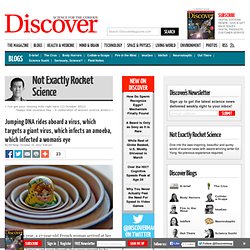
She had been using tap water to dilute the cleaning solution for her contact lenses, and even though they were meant to be replaced every month, she would wear them for three. As a result, the fluid in her contact lens case had become contaminated with three species of bacteria, an amoeba called Acanthamoeba polyphaga that can caused inflamed eyes. The mystery of the woman’s inflamed eyes was solved, but Bernard La Scola and Christelle Desnues looked inside the amoeba, they found more surprises. It was carrying two species of bacteria, and a giant virus that no one had seen before—they called it Lentille virus.
Inside that, they found a virophage—an virus that can only reproduce in cells infected by other viruses—which they called Sputnik 2. How to make a beta cell divide. An ETH Zurich research team-in collaboration with Roche Pharmaceuticals- has discovered a hitherto unknown mechanism by which the insulin producing beta cells are negatively affected.

This raises new hopes for pharmacologically stimulating these cells to divide and thus combating diabetes. Bace1 is by no means an unknown enzyme. It is the protease cleaving the amyloid protein in the brain and is thereby significantly contributing to the pathogenesis of Alzheimer’s disease. Bacteria yield clues about why proteins go bad in ALS and Alzheimer’s. Scientists are unsure why proteins form improperly and cluster together in bunches, a hallmark of neurodegenerative diseases such as amyotrophic lateral sclerosis (ALS), Alzheimer’s and Mad Cow Disease.

In the Nov. 1 issue of the journal Molecular Cell, Yale scientists shed light on protein aggregate formation by studying the process in bacteria. “The question we are all asking is what happens when protein synthesis goes wrong?” Said Jesse Rinehart, assistant professor of cellular and molecular physiology at Yale’s West Campus and co-senior author of the paper. Proteins are created from instructions encoded in DNA and assembled in ribosomes within the cells. Press Release: "UC Santa Barbara Scientists Learn How to Unlock the Destiny of a Cell: A Gift for the Tin Man? " UC Santa Barbara Scientists Learn How to Unlock the Destiny of a Cell: A Gift for the Tin Man?
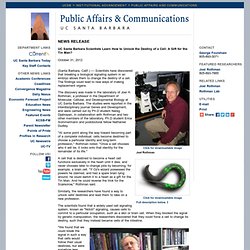
(Santa Barbara, Calif.) –– Scientists have discovered that breaking a biological signaling system in an embryo allows them to change the destiny of a cell. The findings could lead to new ways of making replacement organs. The discovery was made in the laboratory of Joel H. Rothman, a professor in the Department of Molecular, Cellular, and Developmental Biology at UC Santa Barbara. The studies were reported in the interdisciplinary journal Genes and Development, and were carried out by Ph.D student Nareg Djabrayan, in collaboration with Rothman and two other members of the laboratory, Ph.D student Erica Sommermann and postdoctoral fellow Nathaniel Dudley. "At some point along the way toward becoming part of a complete individual, cells become destined to choose a particular identity and long-term profession," Rothman noted. Noncoding DNA. Network Context and Selection in the Evolution to Enzyme Specificity.